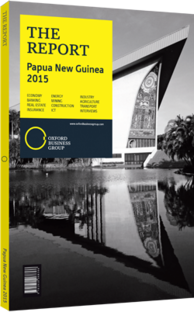PNG's contractors are busy preparing for the 2015 Pacific Games
The construction boom from the Papua New Guinea liquefied natural gas project may be slowing after years of fast growth, but the sector is still in the midst of expansion, led by infrastructure projects ahead of the 2015 Pacific Games. An opportunity to showcase the country’s rapid development and natural beauty, the games prompted major upgrades to stadia and transport networks, to the benefit of private contractors.
Winning Bid
The games, which took place July 4-18, 2015, attracted more than 3000 athletes and thousands of spectators from 21 neighbouring Pacific nations, with 28 separate sporting events. This marked the third time that PNG had hosted the event, and coincided with celebrations marking 40 years of independence.
The arrival of thousands of tourists for the games gave extra impetus to existing infrastructure development plans, with a wide array of construction projects, including stadia and airport upgrades, and the building of commercial facilities, helping to underpin construction sector growth in 2015.
Good Timing
With GDP growth set to reach 15% in 2015, according the Asian Development Bank (ADB), the government now has the fiscal space needed to move forward on infrastructure projects. After the 2014 budget increased infrastructure spending to PGK2.7bn ($1bn), including PGK180m ($68.1m) related to the Pacific Games, the 2015 budget promised even higher spending, with an estimated PGK360m ($136.2m) for Pacific Games infrastructure alone. According to the National Capital District Commission, more than PGK3.2bn ($1.2bn) in infrastructure projects were under way in August 2014, including PGK200m ($75.7m) for an athletes’ village at the University of PNG, PGK109m ($41.3m) for the Taurama Aquatic Centre and over PGK260m ($98.4m) for stadia upgrades.
Airport
Infrastructure upgrades were critical as the country prepared for an influx of visitors, with Jackson’s International Airport (JIA) in Port Moresby, PNG’s sole international airport, handling more than 1.5m passengers annually, despite maximum capacity of closer to 400,000. The PGK140m ($53m) expansion was completed in July 2015. JIA’s terminal facilities can now process up to 2m passengers per year, while efficiency improvements have reduced the average passenger processing time from 7-10 minutes to three. The next phase, which plans to expand another 26,000 sq metres of the terminal building, will help to further absorb rising passenger numbers ahead of the 2018 APEC summit, also to be hosted by PNG.
Stadia
The government has invested heavily in stadia upgrades, including PGK60m ($22.7m) for refurbishments at the Sir John Guise Indoor Complex, which doubled its capacity to 2000 people. The construction contract for the project was awarded to Phoenix Construction, with New Zealand’s Peddle Thorp Architects acting as project designer. Peddle Thorp also provided design work for the 15,000-sq-metre Taurama Aquatic and Indoor Sports Centre.
Port Moresby has also welcomed PGK150m ($56.8m) in outside investment to reconstruct a multipurpose stadium to replace the Sir Hubert Murray Stadium in Port Moresby. The sprawling complex is being constructed in the heart of the city, offering a football and rugby field, gymnasium, and facilities for Paralympics events and weightlifting, with total capacity of 18,000.
Steady wins the Race
According to a report from the Department of Treasury, although construction on Pacific Games projects was delayed by six months, progress was largely satisfactory thereafter, with overall implementation at 65-70% by early 2015, and the games going ahead as scheduled in July.
Thanks to preparations for the Pacific Games and investment in public infrastructure development, the construction sector is likely to witness a modest recovery in 2015, with the ADB forecasting expansion of 3.8% for the year, helping contractors to maintain growth and profits into 2016. According to contractors that OBG spoke with, however, overspending on the games has also resulted in delays in payment from the government and work on some projects remains on hold.
You have reached the limit of premium articles you can view for free.
Choose from the options below to purchase print or digital editions of our Reports. You can also purchase a website subscription giving you unlimited access to all of our Reports online for 12 months.
If you have already purchased this Report or have a website subscription, please login to continue.

